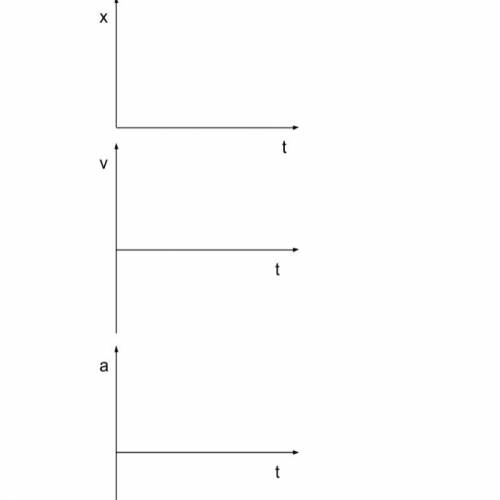
Directions: Construct a quantitative (include numbers) position vs time graph, a velocity vs time graph, and an acceleration vs time graph for the following scenarios.
While cruising along a dark stretch of highway at a speed of 25 m/s, you see that a bridge ahead has been washed out. You apply the brakes and uniformly slow down to a stop in 5.0 seconds.
The velocity values are __negative_. (Positive/Negative)
The acceleration value is ___negative_. (Positive/Negative)
Therefore the object must be ___speeding up_. (Speeding Up/Slowing Down)
2. A poorly tuned Yugo can accelerate from rest to a speed of 28 m/s in 20 s.
The velocity values are __positive_. (Positive/Negative)
The acceleration value is _positive_. (Positive/Negative)
Therefore the object must be __slowing down_. (Speeding Up/Slowing Down)
A bear is sitting at rest at t=0s. At t=5s, the bear notices honey 16 m away and takes off from rest accelerating at a rate of 2 m/s2 for 4 seconds to reach the honey.
In Part 2 of the Motion:
The velocity values are __positive_. (Positive/Negative)
The acceleration value is _positive_. (Positive/Negative)
Therefore the object must be __slowing down_. (Speeding Up/Slowing Down)
A dog runs down his driveway with an initial velocity of -5 m/s for 8 seconds, then uniformly increases his speed to -10 m/s in 5 seconds.
In Part 2 of the Motion:
The velocity values are ___negative_. (Positive/Negative)
The acceleration value is _negative_. (Positive/Negative)
Therefore the object must be _speeding up_. (Speeding Up/Slowing Down)
You are driving on the highway at a rate of 40 m/s for 10 seconds when you notice a cop in front of you. Over the next 5 seconds you uniformly slow down to 35 m/s to avoid getting a speeding ticket.
In Part 2 of the Motion:
The velocity values are _positive_. (Positive/Negative)
The acceleration value is __positive_. (Positive/Negative)
Therefore the object must be __slowing down_. (Speeding Up/Slowing Down)
You are traveling 20 m/s when the stoplight in front of you turns red. You step on your break to uniformly slow down to a rest in 5 seconds. You are stopped at the red light for 3 seconds when the light turns green. You speed back up to 20 m/s over the next 5 seconds.
In Part 1 of the Motion:
The velocity values are __negtive _. (Positive/Negative)
The acceleration value is __negaive_. (Positive/Negative)
Therefore the object must be __speeding up_. (Speeding Up/Slowing Down)
In Part 3 of the Motion:
The velocity values are _. (Positive/Negative)
The acceleration value is _. (Positive/Negative)
Therefore the object must be _. (Speeding Up/Slowing Down)
GRAPH ALL THE PROBLEMS


Answers: 1
Other questions on the subject: Physics

Physics, 21.06.2019 17:50, Riplilpeep
Which describes an image that can be produced by a concave lens? the image is real and smaller than the object. the image is virtual and larger than the object. the image is virtual and smaller than the object. the image is real and larger than the object.
Answers: 3

Physics, 22.06.2019 04:00, benpark5370
All the simple machines make work easier to do by changing the or of a force. a. size; type b. work; type c. size; direction d. type; direction
Answers: 2

Physics, 22.06.2019 09:00, reyesortiz6955
In a heat engine if 1000 j of heat enters the system the piston does 500 j of work, what is the final internal energy of the system if the initial energy was 2000 j? 1. write the equation 2.list out your known variables 3.plug the numbers into the equations 4.solve 5.write your solution statement that includes initial energy and final
Answers: 1

Physics, 22.06.2019 21:00, emilyrobles
Which of the following statements comparing electron microscopy and light microscopy is false? which of the following statements comparing electron microscopy and light microscopy is false? both the electron microscope and the light microscope use the same wavelengths for illumination. images produced by light microscopes can be in color, whereas electron microscope images are black and white unless they are artificially colored. the electron microscope has greater resolution than the light microscope. electron microscopes can allow examination of viruses and internal cell structures, whereas light microscopes are limited to objects that are 0.5 micrometers and larger. request answer
Answers: 2
Do you know the correct answer?
Directions: Construct a quantitative (include numbers) position vs time graph, a velocity vs time gr...
Questions in other subjects:

Chemistry, 22.11.2021 19:30


Mathematics, 22.11.2021 19:30

Mathematics, 22.11.2021 19:30

History, 22.11.2021 19:30

Mathematics, 22.11.2021 19:30



Social Studies, 22.11.2021 19:30






